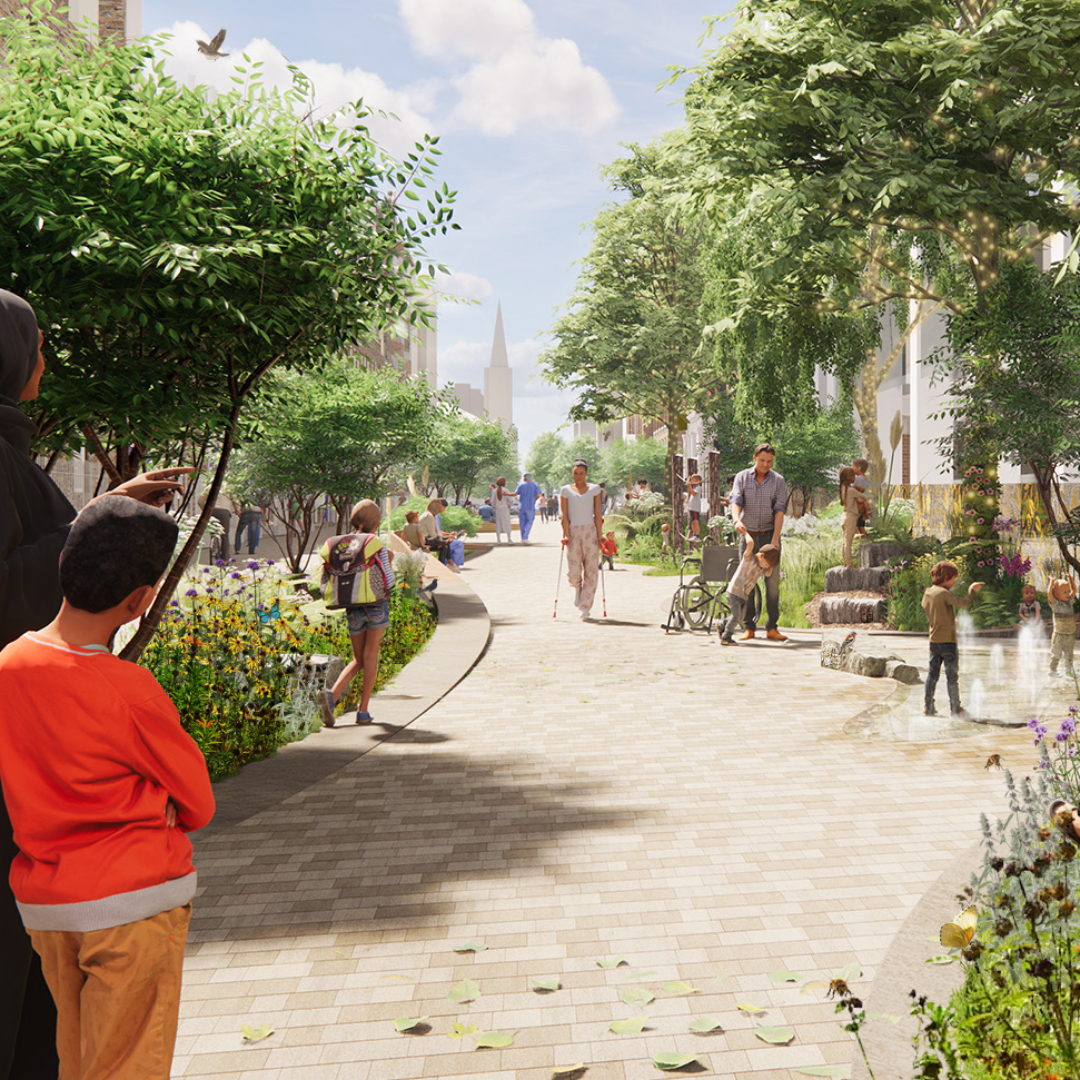Project showcase
Reimagining Great Ormond Street, Camden, London – Great Ormond Street Hospital with LDA Design

London’s Great Ormond Street Hospital is one of the world’s best-known and respected children’s hospitals. However, the streets surrounding the hospital are failing both it and the community. This vision for a reimagined Great Ormond Street is creates a street rebalanced for people – a green and friendly public place to spend time in.
Where is the project located
Great Ormond StreetLondon WC1N 3JH
Who is the developer/client of the project?
Great Ormond Street Hospital
Who is on the project team? (designer, consultants, etc)
LDA Design
Describe the context of this project, its neighbourhood and people?
London’s Great Ormond Street Hospital (GOSH) is one of the world’s best known and respected children’s hospitals. The vision of Dr Charles West, it started life at the house and garden of 49 Great Ormond Street in 1852. Its reputation as a centre of excellence in child healthcare has grown and grown. However, the streets surrounding the hospital are failing both it and the community.Bloomsbury contains fine examples of Regency architecture and is known for its cultural heritage and garden squares, including the British Museum and Coram’s Fields. But Bloomsbury also scores highly in the Index of Multiple Deprivation criteria, for overcrowding and a chronic shortage of green space for local communities. The hospital lacks playable, green, sociable, and inclusive space for patients and families in its vicinity.
Great Ormond Street is unsafe and noisy, dominated by vehicles and traffic. Its air pollution levels frequently exceed World Health Organisation guidelines, which is of particular concern for GOSH which treats children with respiratory disease.
The public realm around GOSH, including its new Children’s Cancer Centre, fails to provide a fitting arrival experience for the 618 children accompanied by concerned parents and carers who arrive daily at the hospital. It does not provide a safe, healthy, child friendly and uplifting place for respite breaks, and for people to meet.
Reimagining the street could address these issues and provide an exemplar for other hospitals to demonstrate how healthcare can integrate seamlessly with community benefit as part of the healthy city.
Please describe your approach to this future place and its mix of uses. How will it function as a vibrant place? How does it knit into, and serve the needs of, the wider area?
The vision for a reimagined Great Ormond Street is ambitious, creating a street rebalanced for people – a green and friendly place to spend time in rather than move through. A place to convalesce and socialise, a street for children and nature.Through reclaiming street space, improvements to ambulance access and patient drop off and changing vehicle access arrangements to both ends of the street, Great Ormond Street will become a nature-inspired place of wellbeing, delight, and escape, as well as a new common ground that patients, workers, visitors, and residents can enjoy together.
A series of beautiful garden rooms invite exploration, play, relaxation, and reflection and so provide a wide spectrum of opportunities for sociability. Each garden room will have its own offer and experience that can either be enjoyed individually or as part of an open-ended choreography of play which extends along the street.
The public realm provides a new setting for historic and new architecture, supporting wayfinding and the easy and safe movement for both pedestrians and cyclists. The distant landmark church spire of St George the Martyr would once again be appreciated from the generous, accessible, and pleasant pedestrian spaces along the street.
The new Children’s Cancer Centre by BDP Architects will create an open, transparent, permeable, and welcoming hospital frontage, that along with the transformed street could transform the hospital’s relationship with its locality, re-integrating it and allowing it to become a strongly connected part of the surrounding community.
What is the environmental impact of the project? How will the carbon use and material impact of the development be mitigated? What is the sustainability strategy?
The sustainability strategy for Great Ormond Street is centred around the transformative change that would be achieved by reducing and re-organising vehicle space and associated traffic movements and using reclaimed space to create an environment that safely supports more active travel, which contributes to carbon-neutral transport in central London.Additionally, the reclaimed space provides opportunities for a significant amount of new, high-quality green infrastructure, with the public realm conceived of as a biophilic, multi-functional, holistic environmental system.
Planting species are selected for ecological value, carbon sequestration, pollutant absorption, nitrogen fixation, potential food sources, and wind, and solar mitigation. They will be low maintenance, with surface water absorbed within a planted SuDS system, which is integrated as part of the street’s structure. The project is targeting a Biodiversity Net Gain in excess of 10% and an Urban Greening Factor in excess of 0.4. Existing site materials will be retained and recycled wherever possible, with new materials selected using the BRE Green Guide to Specification and new low energy lighting systems installed that are ‘dark-skies’ and British Standard compliant.
A critical part of our approach is developing a low-carbon design that considers the whole life of the spaces by auditing at every design stage. This allows us to understand the implications of design decisions in the context of hard and soft materials and associated carbon footprints and carbon sequestration. It aims for a climate positive project as quickly as possible following construction and completion.
Describe the social impact of the project: How will this future place contribute to the economic, environmental and social wellbeing of its citizens?
The purpose of the project is to transform an unsafe and degraded vehicle-dominated environment into a place that delivers significant social, environmental, and economic value for both GOSH and the local community. This is about seeing streets as an important community resource.The project addresses life-threatening issues including poor air quality, potential accidents through vehicle-dominated streets and noise pollution. GOSH analysis of air quality data for Great Ormond Street points to it exceeding levels recommended by the WHO both for NO2 and PM2.5. Daily and long-term exposure to these levels causes respiratory illness and decreased lung function amongst children. Noise is a significant pollutant in the existing street. WHO estimate 16,000 premature deaths and 1.6 million healthy life years are lost across western Europe each year through environmental noise pollution. GOSH is partnering with a specialist to establish the acoustic benefits the project would bring about.
Great Ormond Street would be re-shaped to provide a variety of social spaces and experience supporting social wellbeing; places for quiet reflection, small social groups and special events that would bring the entire community together. The social life of the street would happen in carefully shaped and curated spaces informed by biophilic design principles, reducing stress, improving cognitive performance and mood, and providing the rich natural sensory experience essential for peoples’ wellbeing and physical and mental health. The GOSH play street events have provided a tantalising glimpse of the powerful social impact the project could have.
Festival of Pineapples
24-26 February 2026
Pineapples prize giving night
April
Pineapples at Festival of Place
10 June 2026
© The Pineapples - Tweak Ltd. 124 City Road, London, EC1V 2NX. Tel: 020 3326 7238



